Taiwan's massive 921 earthquake that killed 2291 people created a huge fault displacement, tearing the ground apart for 100 continuous kilometers primarily through urban and suburban areas. The Chelungpu (車籠埔) fault scarp is a scar that will never go away.
Just after 1:47am, the time of the initial earthquake, You shu-fong (
One year later, in Fengyuan (豐原), only 7km from Taichung, I walked along Highway 3. Through the barren swath of dusty vacant lots where homes and buildings once stood, I was confronted with the harsh reality of how many lives had been destroyed by the earthquake. Experts now know more about how deaths and injuries could have been prevented. But serious questions remain as to whether the responsible parties in Taiwan have learned from this tragedy.
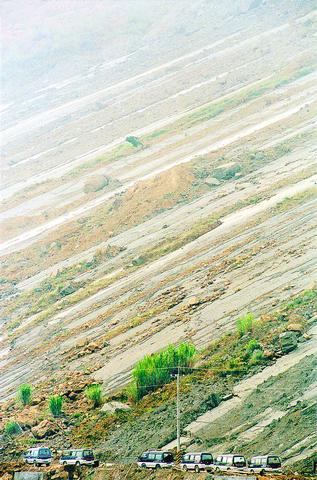
PHOTO: CHEN CHENG-CHANG, TAIPEI TIMES
At the nearby Tachia river (
At National Taiwan University, Dr Chen Yue-gau (
The reason Taiwan exists at all is because of what geologists call decollement or "the snowplow theory." As the Philippine sea plate collides with the Eurasian continental plate, it acts as a snowplow. Sediments that had been lying on the bottom of the sea are "squeezed up into mountains and pushed westward. The thrust faults are penetrating right into the surface one by one westward," said Chen. The Chelungpu fault runs counter to this argument because it is east of the trend.
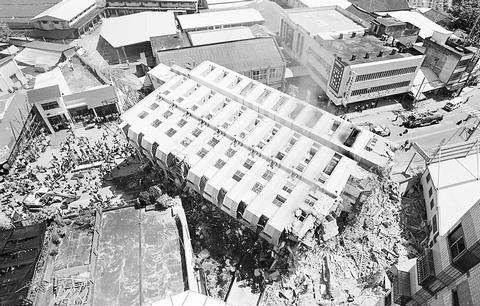
PHOTO:SUNG CHIH-HSIUNG, TAIPEI TIMES
Lack of funds
But usually science can only achieve results as good as the funding behind it, and, as Chen said, government funds were tight because of an attitude of indifference. "Before the earthquake the majority of people didn't have any idea about earthquake disasters," Chen said, who adds that it was way back in 1935 when the last devastating quake hit Taiwan. "People have almost forgotten about these kinds of things. The natural habit in Taiwan is that earthquakes are not very important because the reoccurrence interval is too long -- tens, hundreds or thousands of years.
"There was not enough financial support. We didn't have modern facilities or equipment to monitor crust deformation or for taking high-precision GPS measurements. We just spent our time on field work," Chen said.
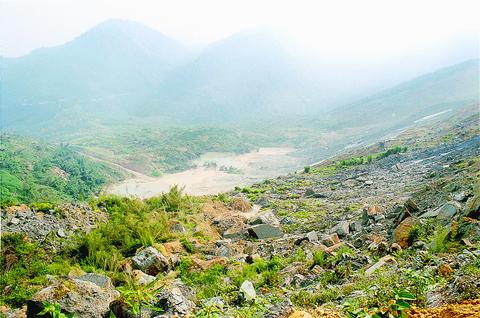
PHOTO: CHEN CHENG-CHANG
However, since the 921 earthquake, Chen feels attitudes have been changing, and earthquake research is receiving more equipment, funds and manpower. "It is a little bit late, but still not too late if we can prepare for another one. Now we can tell our government where the most dangerous place will be, and what the probability of an earthquake is," he said.
But although the earthquake was unexpected, many engineers think there should not have been so many building collapses leading to loss of life.
Loh Chin-hsiung (
Chen Hsue-bin (
Although nothing could be done about the 10 percent of total deaths in buildings directly on the fault which were immediately wrenched in half, most deaths were related to poorly built structures which collapsed in other areas. "Two-thirds of the people died in poorly built buildings," Chen said. "We should have at least avoided these casualties."
Bad policies
But Chen thinks these people died "because of bad policies."
"Ninety-nine percent of present building jobs are run by architects. There are no engineers involved," said Chen who explained that current laws do not ensure that people will follow building codes and are not strict enough to require engineers experienced in earthquake or structural engineering to be part of any building project. In spite of the earthquake, the laws remain almost unchanged to this day
Dr Shannon Lee (
"Seismic engineering," Chen added, "involves lots of detail and special design, called ductile design. Most architects don't understand ductile design, but they think they can do it. They don't think it's that important."
Engineers think the facts speak for themselves. "None of the collapsed buildings where people died were over 16 stories because these buildings must be designed by structural engineers, and they need to be double-checked," Chen said. There are over 200 of these tall buildings in the earthquake disaster area, primarily in Taichung. However, "the 12-story high-rise buildings just completely collapsed. Even in the strongest earthquake there shouldn't be a total collapse," Chen said. He explained that buildings 12-stories and less do not need inspections or a structural engineer, only a civil engineer. "At most, five percent of civil engineers in Taiwan have training in structural engineering," Chen said.
"For buildings five stories or below an architect can do the structural design," said Chen. "A building is still a building. Any kind of building needs to be designed right -- it doesn't matter how high or low," he said.
"Our building policy is really copied from Japan," Lee said. He explained that in Japan architects also have control and authority over the construction process but there are comparatively fewer poorly designed buildings. "In Japan, structural engineering training is included in the architecture department," Lee said, explaining that in Japan architects are more qualified than in Taiwan. However, he said, "the architects in both the US and Taiwan are always proud of not being engineers. They are artists."
In the US, architects do not usually have as much control over projects, and the process of ensuring quality is different. "Professional liability is different," Chen said.
"Many things in the Taiwan system are copied partially from Japan, partially from the US. But put together it's not right. They choose what they want and if there's some other part they don't want they just delete it, and that's not right," Chen said.
Unlike Turkey's August 1999 earthquake leading to outright devastation due to faulty construction by corrupt contractors, Chen thinks Taiwan's system "has nothing to do with corruption. It's just bad policy."
Lee's opinion is similar. "In Taiwan, maybe only about five percent of people intentionally make bad buildings," he said.
In Taiwan, "three lawsuits resulted in sending three or four people to prison. This included architects and engineers. Sixty architects have been sued. Most of the cases have not yet been settled," Chen said.
If anything has changed for the better it is that the larger construction companies are now paying more attention to the law. "The government is checking now. The construction companies are aware and are acting more responsibly. They're scared," Chen said, "But this is not true for architects because the buildings are still not designed by qualified people."
Better protection
The government has made changes in the past year which it says will better protect people from dangerous buildings.
"Originally," Loh said, whose center is key in advising the government, "we had four zones in our seismic design code ... but now it has become two zones," he said, referring to the fact that areas of Taiwan have been categorized into two zones requiring stricter building codes. Besides re-zoning, Loh said modifying the building codes is the second major part of the government's initiative.
But how can the government make sure the contractors and builders follow the building codes?
"I think that belongs to education," Loh said. "In our center we have a program to educate the general public to let them know what kind of structural system or construction is a good one."
Chen disagrees. "What he says is completely wrong. Ordinary people don't have that kind of knowledge and they don't need to have that kind of knowledge -- because this is a real specialty. Loh says that because he's a government speaker. I argue with him all the time."
"[The new building codes and zoning laws] gave people the wrong impression -- that we need a stricter code, but it's not true," Chen said.
Both Chen and Lee emphatically believe that the only way to improve building quality is to require people qualified in structural engineering to design structures and to have experts double-check the structural quality.
"We are pushing for tougher legislation," said Chen. "If you design a building that collapses and kills people and if an investigation finds you are responsible -- you will get life in prison. But the architects have their friends in the Legislative Yuan -- they are trying to stop the legislation," he said.
"Architects," Lee said, "make up [a large portion] of the Construction and Planning Administration and they keep up pressure so that architects keep the jobs.
"In this country, architects have a lot of political power," Chen said. "Most of the building officials in the local governments are architects," he said.
"Change," Chen emphasized, "must come from educating people about the problem. It must be handled through everybody's effort."
Gregory Michaels was a planetary geologist at NASAs Jet Propulsion Laboratory from 1990 to 1993, a NASA research assistant from 1993 to 1998 and a geophysicist in Azerbaijan from 1998 to 1999.
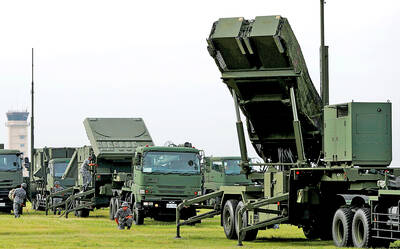
MILITARY BOOST: The procurement was planned after Washington recommended that Taiwan increase its stock of air defense missiles, a defense official said yesterday Taiwan is planning to order an additional four PAC-3 MSE systems and up to 500 missiles in response to an increasing number of missile sites on China’s east coast, a defense official said yesterday. The official, who spoke on condition of anonymity, said that the proposed order would be placed using the defense procurement special budget, adding that about NT$1 trillion (US$32,88 billion) has been allocated for the budget. The proposed acquisition would include launchers, missiles, and a lower tier air and missile defense radar system, they said The procurement was planned after the US military recommended that Taiwan increase

POLITICAL AGENDA: Beijing’s cross-strait Mid-Autumn Festival events are part of a ‘cultural united front’ aimed at promoting unification with Taiwan, academics said Local authorities in China have been inviting Taiwanese to participate in cross-strait Mid-Autumn Festival celebrations centered around ideals of “family and nation,” a move Taiwanese academics said politicizes the holiday to promote the idea of “one family” across the Taiwan Strait. Sources said that China’s Fujian Provincial Government is organizing about 20 cross-strait-themed events in cities including Quanzhou, Nanping, Sanming and Zhangzhou. In Zhangzhou, a festival scheduled for Wednesday is to showcase Minnan-language songs and budaixi (布袋戲) glove puppetry to highlight cultural similarities between Taiwan and the region. Elsewhere, Jiangsu Province is hosting more than 10 similar celebrations in Taizhou, Changzhou, Suzhou,
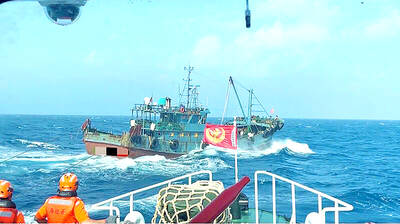
COGNITIVE WARFARE: Chinese fishing boats transmitting fake identification signals are meant to test Taiwan’s responses to different kinds of perceived incursions, a report said Chinese vessels are transmitting fake signals in Taiwan’s waters as a form of cognitive warfare, testing Taipei’s responses to various types of incursions, a report by the Institute for the Study of War said on Friday. Several Chinese fishing vessels transmitted fake automatic identification system (AIS) signals in Taiwan’s waters last month, with one mimicking a Russian warship and another impersonating a Chinese law enforcement vessel, the report said. Citing data from Starboard Maritime Intelligence, the report said that throughout August and last month, the Chinese fishing boat Minshiyu 06718 (閩獅漁06718) sailed through the Taiwan Strait while intermittently transmitting its own AIS

CHINESE INFILTRATION: Medical logistics is a lifeline during wartime and the reported CCP links of a major logistics company present a national security threat, an expert said The government would bolster its security check system to prevent China from infiltrating the nation’s medical cold chain, a national security official said yesterday. The official, who wished to stay anonymous, made the remarks after the Chinese-language magazine Mirror Media (鏡周刊) reported that Pharma Logistics (嘉里醫藥物流) is in charge of the medical logistics of about half of the nation’s major hospitals, including National Taiwan University Hospital and Taipei Veterans General Hospital. The company’s parent, Kerry TJ Logistics Co (嘉里大榮物流), is associated with the National Committee of the Chinese People’s Political Consultative Conference (CPPCC) and the Chinese People’s Liberation Army (PLA), the